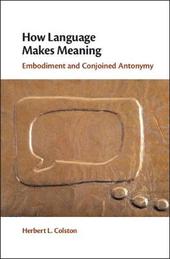
|
How Language Makes Meaning: Embodiment and Conjoined Antonymy
Hardback
Main Details
| Title |
How Language Makes Meaning: Embodiment and Conjoined Antonymy
|
| Authors and Contributors |
By (author) Herbert L. Colston
|
| Physical Properties |
| Format:Hardback | | Pages:300 | | Dimensions(mm): Height 235,Width 156 |
|
| Category/Genre | Psycholinguistics |
|---|
| ISBN/Barcode |
9781108421652
|
| Classifications | Dewey:401.43 |
|---|
| Audience | |
|---|
| Illustrations |
Worked examples or Exercises
|
|
Publishing Details |
| Publisher |
Cambridge University Press
|
| Imprint |
Cambridge University Press
|
| Publication Date |
7 November 2019 |
| Publication Country |
United Kingdom
|
Description
Language's key function is to enable human social interaction, for which people are motivated to engage by powerful brain mechanisms. This book integrates recent work on embodied simulations, traditional meaning-making processes and a myriad of semantic and other meaning contributors to formulate a new model of how language functions following a pattern of conjoined antonymy. It investigates how embodied simulations,semantic information, deviation, omission, indirectness, figurativity, language play, and other processes leverage rich meaning from only a few words by using inherently biological, cognitive and social frameworks. The interaction of these meaning-making components of language is described and a language-functioning model based on recent neuroscientific research is laid out to allow for a more complete understanding of how language operates.
Author Biography
Herbert L. Colston is Professor and Chair for the Department of Linguistics at the University of Alberta, Canada.
Reviews'If you are a linguist, psychologist, or social scientist interested in how language is expanded and manipulated in actual use, this book will enthuse you. With in-depth analyses of real-world conversations, media fragments, and literary texts, the author masterfully shows how figurative, imprecise, indirect, and playful speech shapes communication.' Dirk Geeraerts, Katholieke Universiteit Leuven, Belgium 'This is a marvelous monograph. It convincingly argues that meaning-making is prompted by conjoined antonymous parts. The other key feature of the book is how neurologically driven social motivations intertwine with the functioning of the 'other side of meaning' processes, which arise from the interaction of language with a myriad of mental and social processes.' Angeliki Athanasiadou, Aristotle University of Thessaloniki, Greece 'The renowned cognitive psychologist and linguist Herbert L. Colston shows how meaning is created in language through 'embodied simulations'. Written in a non-technical style and using examples from popular culture or personal anecdotes, this book explains how omission, indirectness, and figurativeness maximize the meaning of what is said by assisting patterns of pragmatic effects.' Linda Thornburg, Co-editor of the book series 'Human Cognitive Processing' 'This book breaks new ground by furnishing familiar models of 'meaning making' with new outfits. It provides a guided tour through the adjacent territories of linguistics and psychology, with abundant examples from current language-in-use. Importantly, the book also builds a bridge between recent experimental psycholinguistic findings and classical semiotic conceptualization.' Jacob L. Mey, Syddansk Universitet
|